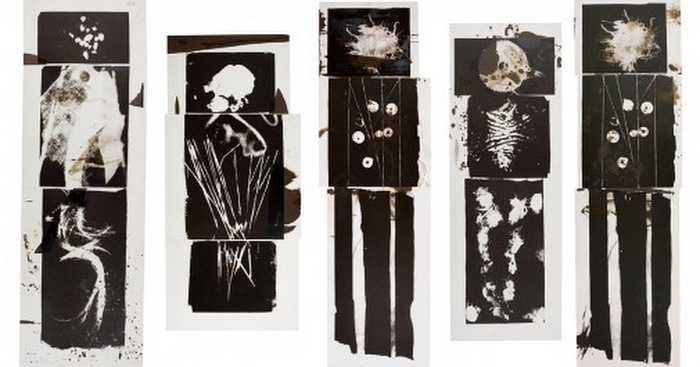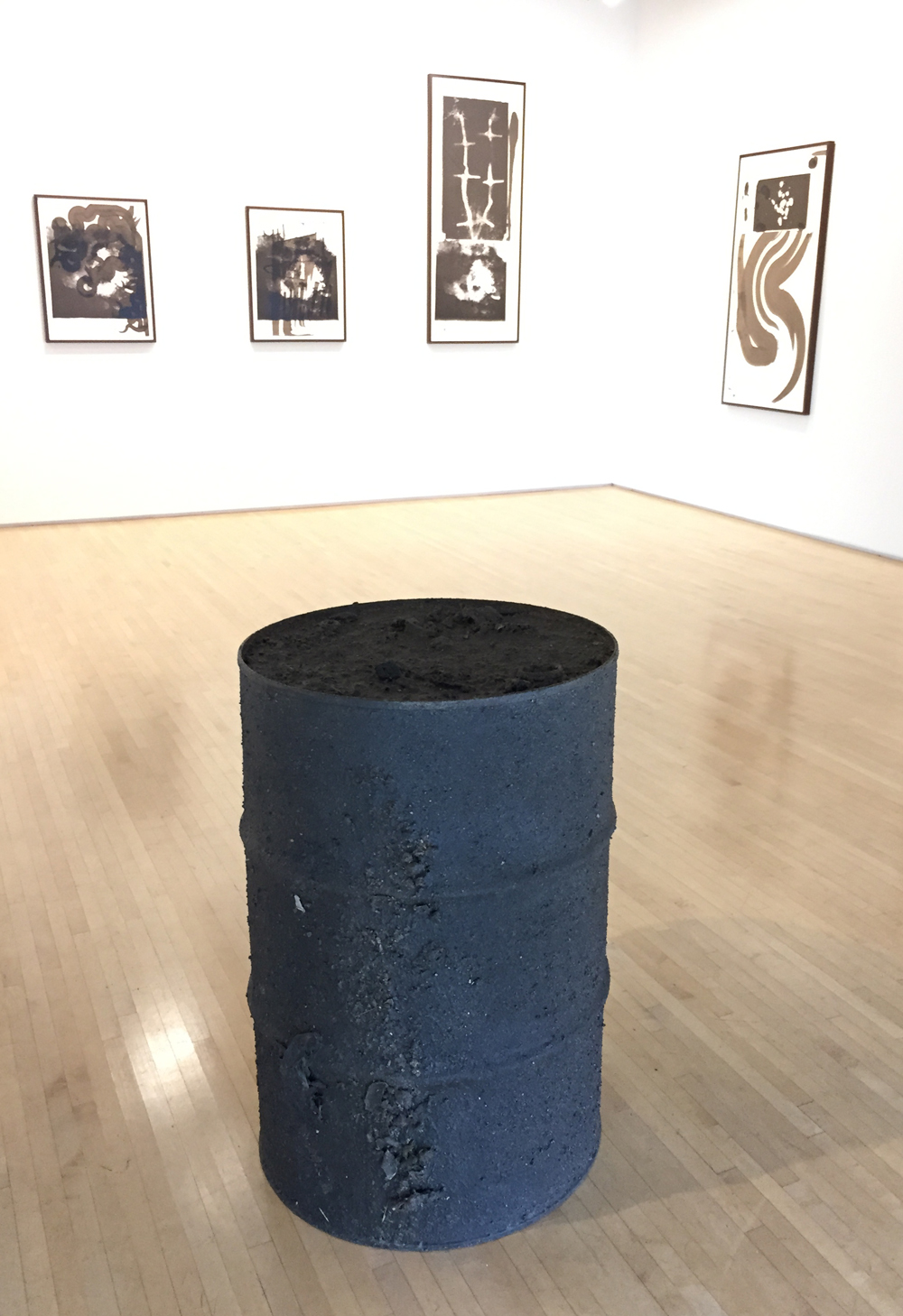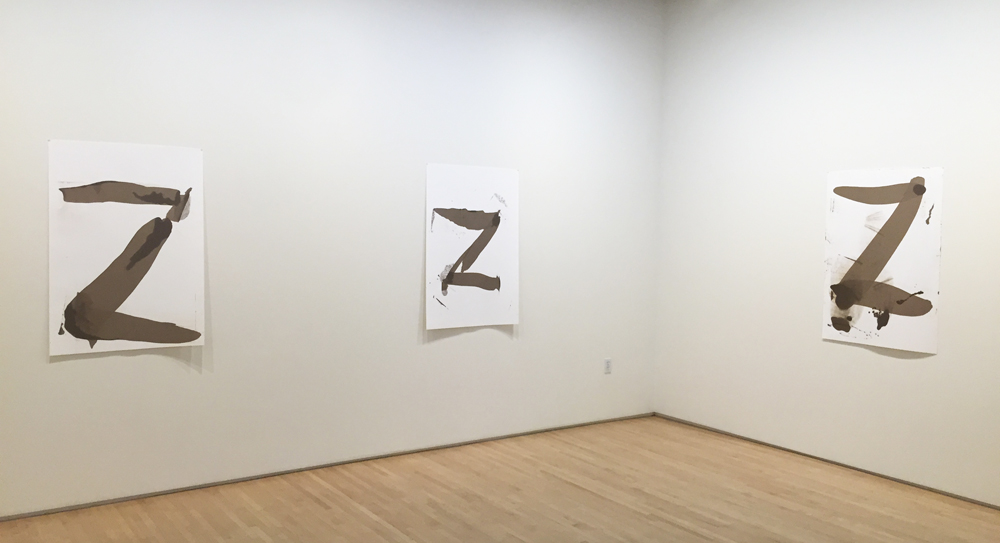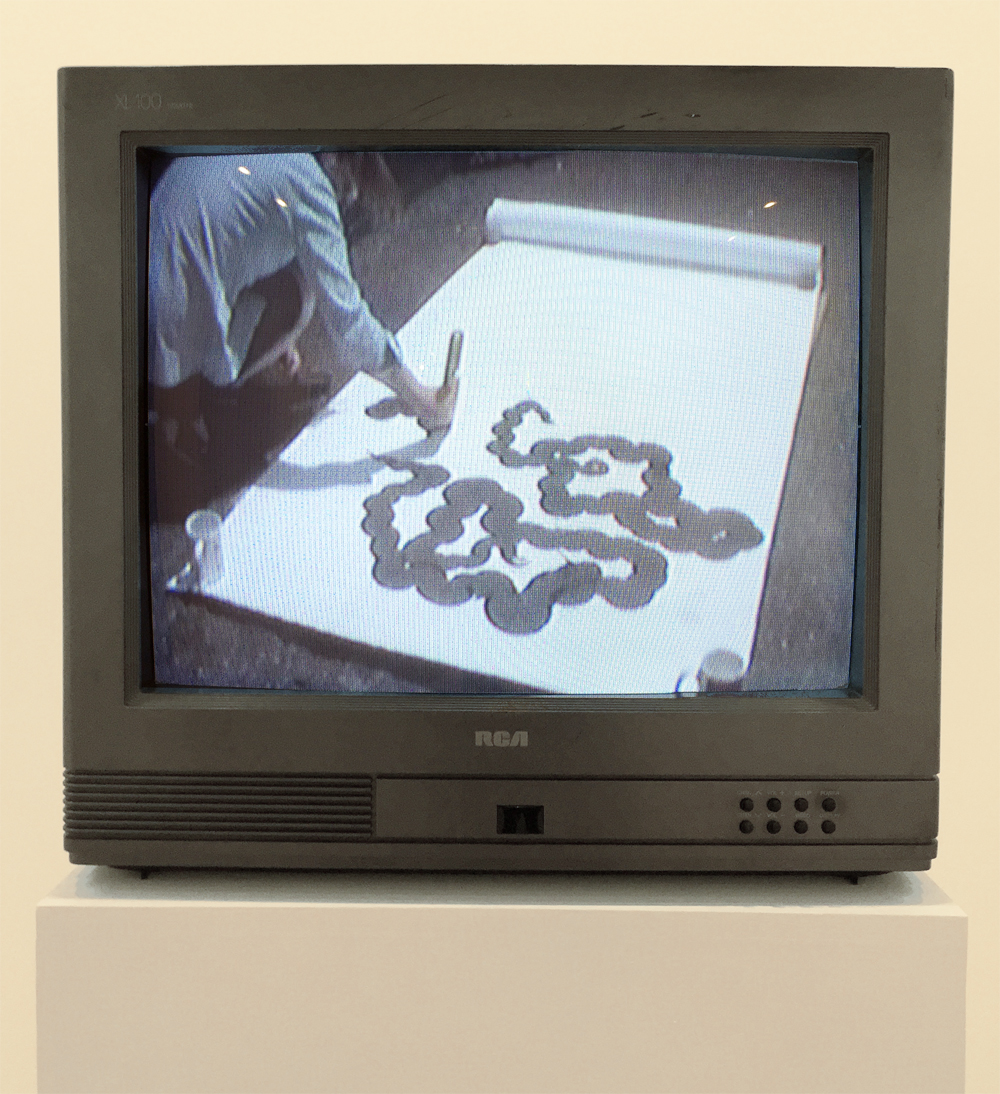
Now Showing: Niet Voor Kinderen
Published November 4th, 2015 by Russ White
A clear view into the murky works of Jay Heikes showing at Highpoint Center for Printmaking now through November 21st
Translated from Dutch, “Niet Voor Kinderen” means “not for children,” and it is a fitting title for this show. Process heavy and body-centric, Jay Heikes’ exhibition of new prints, drawings, and mixed media work initially comes off as quite serious, if not borderline macabre.
The front exhibition space is dominated by several large black and white monoprints. Well, brown and white really. Similar in scale and proportion to human bodies, the pieces here are actually based on the exquisite corpse, an old Surrealist parlor game in which participants take turns writing phrases or drawing a figure collaboratively, blind to what the others have written or drawn. Here, Heikes has decided to play the game all by himself, interchanging cyanotypes of random objects (bundles of hair, plant stalks, washers and trinkets) as the head, torso, and legs of these stylized figures. The cyanotypes were then printed onto paper, either through lithography or screenprint, and hand-embellished with loose brushstrokes, tight organic shapes that resemble coiled intestines, and brown splatters apparently made with a turkey baster. The resulting pieces hang on the wall like abstracted Shrouds of Turin, man-sized stick figures made up of funereal x-rays printed in dirty brown ink.
Except that Heikes did not use ink. The brown tones range from almost black at their heaviest to a diluted sepia in the hand-coloring; at a glance, they look almost like coffee stains. If you’ve ever used roofing tar, you might notice some similarities there as well (and with good reason). That’s because all of the work here was printed and painted with asphaltum, a naturally-occurring, tar-like form of petroleum. It is now synthetically produced as well, but it’s been washing ashore for millennia after seeping from cracks in the earth. Asphaltum has a rich history of different uses ranging from ancient pottery glazes to modern day road construction (it’s the primary adhesive in, you guessed it, asphalt).
Asphaltum does have common applications in the art world, mostly as an etching resist for printmakers. Oil painters used to use it as well, despite the fact that it was non-archival, had a tendency to crack over time, and would sometimes slowly destroy the other pigments it touched. But let’s not forget asphaltum’s most delightfully morbid use: filling the organ cavities of ancient Egyptian mummies. That’s actually how it came to be used by painters: someone in the 16th century had the bright idea to start grinding up mummies. The pigment this produced came to be known as “mummy brown.”
 Mummy Brown, dirt, steel slag, glue, paper, and oil drum, 2015
Mummy Brown, dirt, steel slag, glue, paper, and oil drum, 2015
At this point, you might start seeing the gallows humor in Heikes’ work. While the prints might look dreadfully serious, with their bits of tree root and horse hair straight out of True Detective’s Carcosa, it is helpful to remember their genesis as exquisite corpses (both in terms of the parlor game and the mummies themselves). Heikes is being playful with history, with material, and with our expectations of high art. Standing apart from all of the work in the front room is a black, dirt-encrusted oil barrel titled Mummy Brown. It is an odd piece, surprisingly literal compared to the rest of the work, and its lack of poetry is off-putting. My guess is that that’s on purpose: the artist wants to highlight his crude choice of medium with a crusty, mundane barrel of the stuff.
In the second room of the show, you encounter several large gestural paintings of the letter Z in that familiar fecal brown. Painted quickly with a wide brush and diluted asphaltum, they look like the calling cards of a fat Zorro. Another way to read them is as one giant cartoon snooze; as Heikes says in his statement, “the Z’s became a way for me to laugh about boring a viewer to death.”
 Installation view
Installation view
On a pedestal in the middle of one wall is a small, ‘90s-era RCA tube television, playing a long, bizarre, VHS-quality video the artist put together. Depending on when you start watching (and decide to stop), you could see (among other vignettes) a nearly naked man being covered in chopped vegetables, a process shot of Heikes painting one of his brown intestines with a palette knife, or what is effectively a music video for the MIA song “Paper Planes” that he shot at… wait for it… the MIA. It’s a corny joke that’s saved by his choice of a good song and his focus on all of the dismembered marble bodies at the museum. Even at his most sarcastic, Heikes still has his eye on history and the human body. Indeed, he begins that segment of the video by walking out of a port-a-john across the street from the museum’s entrance.
 Daily Rituals (Sickday), video on DVD, 2015
Daily Rituals (Sickday), video on DVD, 2015
Between that and the other scatalogical references throughout the show, I don’t think I’m going too far out on a limb to say that “Niet Voor Kinderen” is about taking a shit on the art world. The show vascillates between the high and the low: the monoprints use multiple technical processes but are then printed with nonarchival material; the beautiful compositions of delicate objects in one room contrast with the big sloppy Zs in the other. And Heikes is no stranger to the art world either: he earned an MFA from Yale and has shown work at the Walker and the Whitney, among other institutions. He has achieved that difficult balance here of producing some very striking and sophisticated work while also having a good laugh at it all. That, my friends, is no child’s play.
Niet Voor Kinderen : New Prints by Jay Heikes runs through November 21st at Highpoint Center for Print Making
We can't do it without you.
Help keep independent arts journalism alive in the Twin Cities.